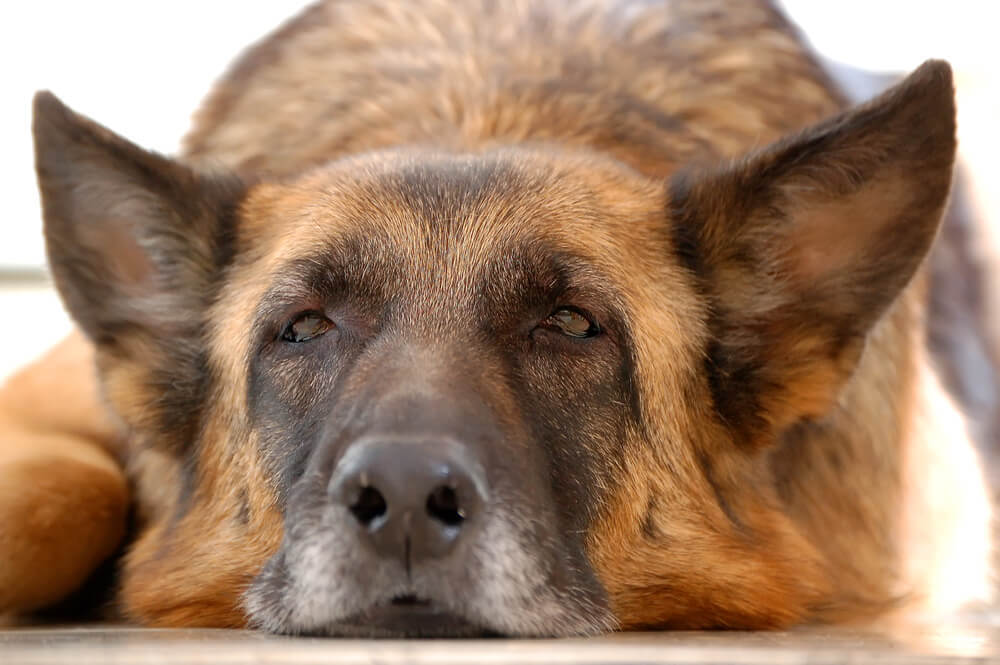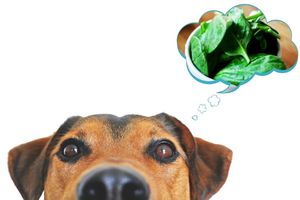You wander over to the fridge and take the pint of Ben and Jerry's out to enjoy in front of the TV with your partner. You hadn't counted on your dog wanting to join in on the treat.
As you taste the first spoonful of that creamy, rich cocoa flavor, you wonder if it's okay to feed your dog some? After all, everyone deserves a treat from time-to-time, right?
Stop! Before you feed your dog that chocolate ice cream, read the rest of this post, your pup will thank you for being a responsible pet owner by the end.
Can dogs eat ice cream?

Sure, dogs can eat ice cream – they'll eat practically anything you put in front of them, even if it kills them. Dogs don't have common sense, and they rely on you to make the judgment call for them, even if they don't agree with your decision.
The reality is that you need to put down that Ben and Jerry's and forget about feeding it to Fido. Some dogs can stomach ice cream, while others end up with severe gastric distress. Ice cream might taste good to you and me, but it's a toxic cocktail that dogs need to avoid.
Some of the adverse health effects of your dog eating ice cream include the following:
- Tooth decay and gum damage
- Ice cream can activate food allergies
- Ice cream messes with your dog's blood sugar levels
- Sugar consumption can lead to behavioral changes
- Some ingredients in ice cream may cause toxic effects in dogs
- Eating ice cream can lead to the development of diabetes in dogs
- It causes digestive issues in dogs
- Can cause severe digestive problems if your dog has lactose intolerance
- Eating sweet treats often leads to a gain in body weight
Can dogs have chocolate?

Under no circumstances should you ever feed your dog chocolate. Sure, take them trick-or-treating with you, but keep them out of the candy bowl. Chocolate is another toxic cocktail to dogs. Several ingredients in chocolate can cause catastrophic health issues in dogs. Let's unpack these ingredients in detail.
Methylxanthines (Theobromine) and caffeine
The methylxanthines in chocolate cause health issues in your dog if they decide to steal that chocolate bar and chow down. The dangerous methylxanthines in chocolate are caffeine and theobromine.
Both compounds produce similar effects in your dog, with the theobromine effects lasting longer than caffeine results. The more chocolate liquor used by the manufacturer in the chocolate product, the higher the concentrations of theobromine, and the more pronounced the effect on your dog.
Baking and dark chocolate are the worst types for your dog, producing a terrible outcome in the animal. Exposure to the theobromine in chocolate causes the following symptoms of chocolate poisoning in dogs.
- Vomiting and diarrhea
- Hyperactivity and personality shifts
- Tremors and seizures
- Abnormal heart rhythm and high resting heart rate
- In some cases, chocolate consumption can cause death in dogs

Roasted Cocoa Beans
The toxic dose for theobromine in your dog is around 18mg per pound of bodyweight. 9mg causes digestive distress, and amounts over 20mg can kill your dog.
Milk chocolate has 44 mg of theobromine per ounce of chocolate, while semisweet milk chocolate contains 150 mg p/oz, and baking chocolate 390 mg p/oz.
White chocolate does not come from the cocoa bean. Therefore, it includes no theobromine, but it's high in fat content, causing pancreatitis in dogs.
It can take up to four days for the effects of the chocolate to work its way out of your dog's body. If you see the dog eating chocolate, it's possible to induce vomiting to get your dog to throw up the chocolate. However, if you have no luck with that strategy, we recommend calling the vet right away.
Your vet will want to know how much your dog weighs, the type of chocolate they ate, and how much chocolate they ate. Make sure you make an accurate assessment of both before making the call. If the vet determines you need to bring the dog in for treatment, you'll have to race to the emergency room.
Lactose intolerance
Dogs do not have a digestive system designed to handle dairy products. Other than mothers' milk, when they are puppies, dogs will never touch the stuff. However, most dogs enjoy eating cream, milk, cheese, ice cream, and other dairy products. They don't realize that it's going to give them an upset stomach.
Some dogs are more sensitive than others to the lactose in dairy products like ice cream.
Signs of lactose intolerance in dogs include the following:
- Gas and bloating
- Stomach discomfort
- Lethargy and inactivity
- Gastrointestinal distress
- Vomiting
If your dog starts to display these symptoms within 30-minutes to 120-minutes after eating dairy, they have lactose intolerance, and you should avoid feeding them ice cream.
Your dog should recover after a few hours. However, if the symptoms progress, take them to the vet for diagnosis and treatment.

Xylitol
Sugar-free ice cream brands include sweeteners in the ice cream to improve the taste. However, sweeteners like Xylitol are toxic to your dogs, leading to severe gastrointestinal distress. Xylitol can cause a spike in your dog's blood sugar, leading to signs of fatigue, tiredness, and inactivity.
Unhealthy components
Ice cream contains significant amounts of fats and sugar. Excessive fat consumption leads to the development of pancreatitis in dogs – a life-threatening condition as well as obesity, which in itself brings a host of other health issues for your pet.
How much chocolate is toxic for dogs?
Chocolate is toxic for dogs in varying amounts. The reaction depends on the type of chocolate and the size of the animal. Here is a quick guide to assessing chocolate toxicity in dogs.
Baking chocolate
Approximately 0.5 oz for a 10-lb dog, 1 oz for a 20-lb dog, and 1.5 oz for a 30-lb dog.
Popular baking chocolate brands include Callebaut, Baker's Chocolate, Guittard, Ghirardelli, Lindt, Valrhona, Scharffen Berger, and Menier.
Dark chocolate
Approximately 1.5 oz for a 10-lb dog, 3 oz for a 20-lb dog, and 4.5 oz for a 30-lb dog.
Milk chocolate
Approximately 3.5 oz (more than two standard Hershey's Chocolate Bars) for a 10-lb dog, 7 oz for a 20-lb dog, and 10.5 oz for a 30-lb require a visit to the vet's office.
Milk chocolate brands include Hershey's, M&M's, kit-Kat, Mars, Kit Kat, Cadbury, Kinder, Toblerone, Kinder, Galaxy, and Ferrero Rocher. Semisweet chocolates also have similar toxicity levels.
White chocolate
This chocolate doesn't cause the same problems as chocolate, but the additional fat can lead to pancreatitis in the animal. However, if you're wondering about the numbers, it would take 47-lbs of white chocolate to send your dog to the vet.
Take Note
If you think your pet may have ingested a potentially poisonous substance call Animal Poison Control at (888) 426-4435.

Is chocolate ice cream bad for dogs?
No, dogs cannot have chocolate ice cream under any circumstances. Feeding them this sweet treat is irresponsible and can land your pet in the emergency room.
While chocolate and ice cream are terrible foods for dogs, combining them into chocolate ice cream is a perfect storm of gastric distress for your dog. Now that you understand the toxicity of chocolate and dairy for your dog, why take the risk of feeding it to them?
My dog ate chocolate ice cream. Should I worry?
If your dog eats chocolate ice cream, you need to adhere to this post's advice to ensure your dog doesn't develop a life-threatening condition. Follow this step-by-step process if you think your dog ate some chocolate.
STEP 1 - Assessment
Look for evidence of the chocolate. Determine how much chocolate your dog ate before calling the vet.
STEP 2 - Call the vet
Call the vet and tell them the problem. Give the vet the details on how much chocolate the dog is, the type of chocolate, and your dog's weight.
STEP 3 - Take action
Your vet will make a quick calculation to determine whether you need to bring the dog in for observation. If your dog doesn't need a trip to the vet, keep an eye on them for the next few days to make sure they're okay.
3 Alternatives to ice cream for dogs
Here are three dog-friendly alternatives to ice cream for your doggo to enjoy but without the health risk.
- Unsweetened Frozen Yogurt: Especially, plain greek yogurt since it contains less lactose than ice cream, no sugar, and less fat.
- Unsweetened Frozen Fruities: Smash up some bananas, strawberries, and blueberries in a bowl, pack the mixture into ice trays and store in the freezer for a sweet treat for your dog on hot days.
- Peanut Butter Banana Balls: Smash some bananas and peanut butter together, fill an ice tray, and store in the fridge for a tasty frozen treat your dog will love.
Be sure to also check out our other related dog food articles dedicated to the safety of foods for pets.





My dog ate Ben Jerry’s Dairy free ice cream with chocolate. What should I do